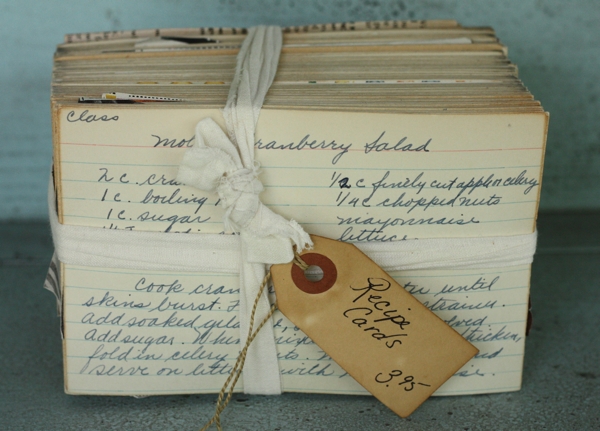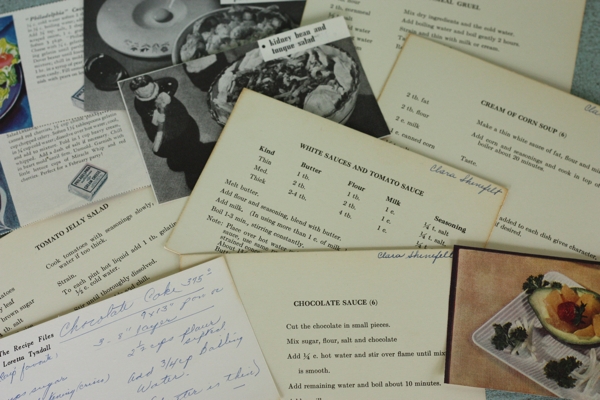In late summer, on a chance visit to an antique store in Milford, Ohio, I spotted a stack of vintage recipe cards, with a tag that read, Recipe cards $3.95.
How could I not?
These vintage recipe cards are beautiful: 4-by-6 index cards, with a bit of golden foxing on the edges. The recipes are written in blue ink (probably using a fountain pen). Tucked into the stack are meticulously clipped recipes from magazines, newspapers and manufacturer’s recipe books. There are a few recipes from other women, but most of the cards are signed by Clara Shenefelt. Some are labeled ‘class’—which makes me think Clara copied the recipes from a cooking class or maybe Home Ec. Many of the recipe cards are dated 1934.
I’ve begun doing a bit of informal research on American home cooking during the 1930s. It was an interesting time: just a few years removed from the hardship, scarcity and food rationing of World War I (1914–1918) and the Great Depression (1929–1933). By the 1930s, refrigerators and electric stoves were common in American kitchens, and appliance manufacturers began publishing recipes to help homemakers make use of these conveniences. Big food companies were becoming household names during this time—Nabisco, General Mills, Kelloggs, Hershey—and these manufacturers also distributed recipes on packaging and in advertising. The Joy of Cooking was first published in 1931.
Clara Shenefelt’s recipe collection gives a peek into American cuisine at the time. She had comparably few recipes for what we would consider entrees or main dishes, and they are fancy, special-occasion recipes like Beef en Casserole ‘Parisian Style’ and Swiss Steak. She had typed out instructions for basic cooking techniques like broiling and roasting; my hunch is that typical American dinners at the time consisted of roasted or broiled meat with several side dishes and dessert.
It’s the latter two categories that dominate this vintage recipe collection. The 1930s housewife probably expressed her culinary creativity with her salads and sweets. I was surprised by the number of recipes for molded dishes: aspics, gelatins and puddings, both sweet and savory, prepared in large or individual decorative molds. Turns out, congealed salads and desserts were quite in vogue during the 1930s, inspired by flavored Jell-O (including the newly introduced lime flavor).
For about 10 seconds, I contemplated a “Julie and Julia” kind of project where I would cook my way through the entire stack (my discovery of a recipe for Smoked Tongue and Kidney Bean Salad put the kibosh on that idea). Still, I knew that something cool must be done with these old recipes, and readers of my food blog, writes4food, agreed.
So, beginning this week will commence The Clara Project—named after Clara Shenefelt, who penned (or typed) these recipes originally.
Once a week, I’ll draw one recipe card from the deck, prepare the dish, photograph it (and the recipe card), and share it on writes4food. Where it’s appropriate, I’ll also include notes on how to modernize the recipe. I’ll talk about what works—and what flops. This exploration will run through the end of the year, unless we have the momentum to keep going.
Part of the fun will be the randomness of the draw, though I reserve the right to a couple of mulligans if I pick something icky (I’ll let you know when I pass on a recipe), and to ingredient substitutions if the recipe calls for cauliflower or brussels sprouts (which are banned in our house, sorry) or items that aren’t readily available as they were in the 1930s (like salt cod or smoked tongue).
I hope you’ll join me in this weekly hop into the culinary Wayback Machine, when we’ll experience what it was like to cook and eat 75 or so years ago. And that you’ll share your own family recipes if anything you see here prompts a memory.
You’re in this with me, right?


Hello, I have my great aunt Lelia’s recipe cards from a 1929 Foods class. She apparently turned in the assignment late and received a “C-“. She aslo wrote them, using a fountain pen.